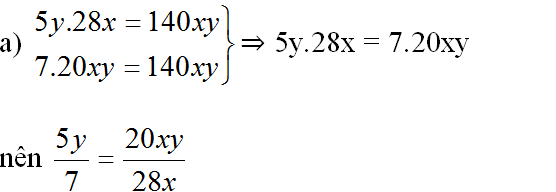Hãy nhập câu hỏi của bạn vào đây, nếu là tài khoản VIP, bạn sẽ được ưu tiên trả lời.

a) A=3x+22(x−1)−3(2x+1)
Gía trị phân thức A được xác định khi 2 (x - 1) - 3 (2x + 1) \(\ne0\)
=> Nếu tìm được x khi phân thức A = 0 thì sẽ tìm được điều kiện của x để giá trị phân thức A được xác định.
Ta có phương trình:
2 (x - 1) - 3 (2x + 1) \(=0\)
hay 2x - 2 - 6x - 3 = -4x - 5 = 0
=> x = (0 + 5) : (-4) = \(\dfrac{-5}{4}\)
Vậy x \(\ne\dfrac{-5}{4}\) thì giá trị phân thức A
=3x+22(x−1)−3(2x+1)được xác định.
b) \(B=\dfrac{0,5\left(x+3\right)-2}{1,2\left(x+0,7\right)-4\left(0,6x+0,9\right)}\)
Gía trị phân thức B được xác định khi 1,2 (x + 0,7) - 4 (0,6x + 0,9) \(\ne\) 0
=> Nếu tìm được x khi phân thức B = 0 thì sẽ tìm được điều kiện của x để giá trị phân thức B được xác định.
Ta có phương trình:
1,2 (x + 0,7) - 4 (0,6x + 0,9) = 0
hay 1,2x + 0,84 - 2,4x - 3,6 = -1,2x - 2,76 = 0
=> x = (0 + 2,76) : (-1,2) = \(\dfrac{-23}{10}=-2,3\)
Vậy x \(\ne0\) thì giá trị phân thức B
=0,5(x+3)−21,2(x+0,7)−4(0,6x+0,9)được xác định.
Sửa lại:
a) \(A=\dfrac{3x+2}{2\left(x-1\right)-3\left(2x+1\right)}\)
Gía trị phân thức A được xác định khi 2 (x - 1) - 3 (2x + 1) ≠0
=> Nếu tìm được x khi phân thức A = 0 thì sẽ tìm được điều kiện của x để giá trị phân thức A được xác định.
Ta có phương trình:
2 (x - 1) - 3 (2x + 1) =0
hay 2x - 2 - 6x - 3 = -4x - 5 = 0
=> x = (0 + 5) : (-4) = \(\dfrac{-5}{4}=-1,25\)
Vậy x ≠ \(-1,25\) thì giá trị phân thức A được xác định.
b) \(B=\dfrac{0,5\left(x+3\right)-2}{1,2\left(x+0,7\right)-4\left(0,6x+0,9\right)}\)
Gía trị phân thức B được xác định khi 1,2 (x + 0,7) - 4 (0,6x + 0,9) ≠ 0
=> Nếu tìm được x khi phân thức B = 0 thì sẽ tìm được điều kiện của x để giá trị phân thức B được xác định.
Ta có phương trình:
1,2 (x + 0,7) - 4 (0,6x + 0,9) = 0
hay 1,2x + 0,84 - 2,4x - 3,6 = -1,2x - 2,76 = 0
=> x = (0 + 2,76) : (-1,2) = \(\dfrac{-23}{10}\)=−2,3
Vậy x ≠ -2,3 thì giá trị phân thức B được xác định.

B3;a,ĐKXĐ:\(x\ne\pm4\)
A=\(\left(\dfrac{4}{x-4}-\dfrac{4}{x+4}\right)\dfrac{x^2+8x+16}{32}=\left(\dfrac{4x+16}{x^2-16}-\dfrac{4x-16}{x^2-16}\right)\dfrac{x^2+2.4x+4^2}{32}=\left(\dfrac{4x+16-4x+16}{x^2-16}\right)\dfrac{\left(x+4\right)^2}{32}=\left(\dfrac{32}{x^2-16}\right)\dfrac{\left(x+4\right)^2}{32}=\dfrac{32\left(x+4\right)^2}{32.\left(x-4\right)\left(x+4\right)}=\dfrac{x+4}{x-4}\\ \\ \\ \\ \\ \\ b,Tacó\dfrac{x+4}{x-4}=\dfrac{1}{3}\Leftrightarrow3x+12=x-4\Leftrightarrow x=-8\left(TM\right)c,TAcó\dfrac{x+4}{x-4}=3\Leftrightarrow x+4=3x-12\Leftrightarrow x=8\left(TM\right)\)

1) \(\dfrac{A\left(x-5\right)}{\left(x+1\right)\left(x-5\right)}=\dfrac{3x\left(x+3\right)}{\left(x+1\right)\left(x+3\right)}\)
\(\Rightarrow A=3x\)
2) \(\dfrac{\left(x+3\right)\left(x-2\right)}{A\left(x-3\right)}=\dfrac{\left(5x-1\right)\left(x-2\right)}{\left(5x-1\right)\left(x^2+3\right)}\)
\(\Leftrightarrow\dfrac{\left(x+3\right)}{A\left(x-3\right)}=\dfrac{1}{\left(x^2+3\right)}\)
\(\Rightarrow A=\dfrac{\left(x^2+3\right)\left(x+3\right)}{x-3}\)
3) \(\dfrac{\left(x-5\right)\left(x+5\right)}{\left(x+5\right)\left(2x-3\right)}=\dfrac{\left(x-5\right)A}{\left(2x-3\right)\left(x+2\right)}\)
\(\Leftrightarrow1=\dfrac{A}{\left(x+2\right)}\)
\(\Leftrightarrow A=x+2\)

a,ĐK: \(\hept{\begin{cases}x\ne0\\x\ne\pm3\end{cases}}\)
b, \(A=\left(\frac{9}{x\left(x-3\right)\left(x+3\right)}+\frac{1}{x+3}\right):\left(\frac{x-3}{x\left(x+3\right)}-\frac{x}{3\left(x+3\right)}\right)\)
\(=\frac{9+x\left(x-3\right)}{x\left(x-3\right)\left(x+3\right)}:\frac{3\left(x-3\right)-x^2}{3x\left(x+3\right)}\)
\(=\frac{x^2-3x+9}{x\left(x-3\right)\left(x+3\right)}.\frac{3x\left(x+3\right)}{-x^2+3x-9}=\frac{-3}{x-3}\)
c, Với x = 4 thỏa mãn ĐKXĐ thì
\(A=\frac{-3}{4-3}=-3\)
d, \(A\in Z\Rightarrow-3⋮\left(x-3\right)\)
\(\Rightarrow x-3\inƯ\left(-3\right)=\left\{-3;-1;1;3\right\}\Rightarrow x\in\left\{0;2;4;6\right\}\)
Mà \(x\ne0\Rightarrow x\in\left\{2;4;6\right\}\)

A=(xy2+xy−x−yx2+xy)(xy2+xy−x−yx2+xy) : (y2x3−xy2+1x+y):xy
A=( \(\dfrac{x}{y\left(x+y\right)}\) - \(\dfrac{x-y}{x\left(x+y\right)}\)) : (\(\dfrac{y^2}{x\left(x-y\right)\left(x+y\right)}\)+\(\dfrac{1}{x+y}\)) : \(\dfrac{x}{y}\)
A=\(\dfrac{x^2-y\left(x-y\right)}{xy\left(x+y\right)}\) : \(\dfrac{y^2+x\left(x-y\right)}{x\left(x-y\right)\left(x+y\right)}\) : \(\dfrac{x}{y}\)
A = \(\dfrac{x^2-xy+y^2}{xy\left(x+y\right)}\) : \(\dfrac{y^2-xy+x^2}{x\left(x-y\right)\left(x+y\right)}\):\(\dfrac{x}{y}\)
A = \(\dfrac{x^2-xy+y^2}{xy\left(x+y\right)}\). \(\dfrac{x\left(x-y\right)\left(x+y\right)}{x^2-xy+y^2}\):\(\dfrac{x}{y}\)
A = \(\dfrac{x-y}{y}\) : \(\dfrac{x}{y}\)
A = \(\dfrac{x-y}{x}\)
A= 1 - \(\dfrac{y}{x}\)>1
=> y/x <0
=> xy<0 , x+y khác 0

\(a,\dfrac{x^2-2x}{x^2-4}=\dfrac{x\left(x-2\right)}{\left(x-2\right)\left(x+2\right)}=\dfrac{x}{x+2}\)
b) \(\dfrac{x^2+5x+4}{x^2-1}=\dfrac{x^2+x+4x+4}{x^2-1}=\dfrac{\left(x+1\right)\left(x+4\right)}{\left(x-1\right)\left(x+1\right)}=\dfrac{x+4}{x-1}\)
c) \(\dfrac{x^4+4}{x\left(x^2+2\right)-2x^2-\left(x-1\right)^2-1}\)
\(=\dfrac{x^4+4x^2-4x^2+4}{x^3+2x-2x^2-x^2+2x-1-1}\)
\(=\dfrac{\left(x^2+2\right)^2-4x^2}{\left(x^3+2x-2x^2\right)-\left(x^2-2x+2\right)}\)
\(=\dfrac{\left(x^2+2-2x\right)\left(x^2+2+2x\right)}{x\left(x^2+2-2x\right)-\left(x^2+2-2x\right)}\)
\(=\dfrac{x^2+2+2x}{x-1}\)
Bài 2:
a) \(\left(\dfrac{2x+1}{2x-1}-\dfrac{2x-1}{2x+1}\right):\dfrac{4x}{10x-5}\)
\(=\dfrac{\left(2x+1\right)^2-\left(2x-1\right)^2}{\left(2x-1\right)\left(2x+1\right)}.\dfrac{5\left(2x-1\right)}{4x}\)
\(=\dfrac{8x}{\left(2x-1\right)\left(2x+1\right)}.\dfrac{5\left(2x-1\right)}{4x}\)
\(=\dfrac{10}{2x+1}\)
b) \(\left(\dfrac{1}{x^2+x}-\dfrac{2-x}{x+1}\right):\left(\dfrac{1}{x}+x-2\right)\)
\(=\dfrac{1-2x+x^2}{x\left(x+1\right)}:\dfrac{1+x^2-2x}{x}\)
\(=\dfrac{1}{x+1}\)
c) Trong ngoặc giữa hai phân số là dấu gì vậy ?

Bài 1: (Sgk/36):
a. \(\dfrac{5y}{7}\)=\(\dfrac{20xy}{28x}\) vì
5y . 28x = 140xy
7 . 20xy = 140xy
=> 5y . 28x = 7 . 20xy
Vậy \(\dfrac{5y}{7}\)=\(\dfrac{20xy}{28x}\)
b. \(\dfrac{3x\left(x+5\right)}{2\left(x+5\right)}\)=\(\dfrac{3x}{2}\) vì
3x . 2(x+5) = 6x2+30x
2 . 3x(x+5) = 6x2+30x
=> 3x . 2(x+5) = 2 . 3x(x+5)
Vậy \(\dfrac{3x\left(x+5\right)}{2\left(x+5\right)}\)=\(\dfrac{3x}{2}\)
c. \(\dfrac{x+2}{x-1}\)=\(\dfrac{\left(x+2\right)\left(x+1\right)}{x^2-1}\) vì
(x+2) (x2-1) = (x+2) (x-1) (x-1)
=> (x+2) (x2-1) = (x-1) (x+2) (x+1)
Vậy \(\dfrac{x+2}{x-1}\)=\(\dfrac{\left(x+2\right)\left(x+1\right)}{x^2-1}\)
d. \(\dfrac{x^2-x-2}{x+1}\)=\(\dfrac{x^2-3x+2}{x-1}\)
(x-1) (x2-x-2) = x3-2x2-x+2
(x+1) (x2-3x+2) = x3-2x2-x+2
=> (x-1) (x2-x-2) = (x2-3x+2) (x+1)
Vậy \(\dfrac{x^2-x-2}{x+1}\)=\(\dfrac{x^2-3x+2}{x-1}\)

Bài 7:(Sbt/25) Dùng tính chất cơ bản của phân thức hoặc quy tắc đổi dấu để biến mỗi cặp phân thức sau thành một cặp phân thức bằng nó và có cùng mẫu thức :
a. \(\dfrac{3x}{x-5}\) và \(\dfrac{7x+2}{5-x}\)
Ta có:
\(\dfrac{3x}{x-5}=\dfrac{-\left(3x\right)}{-\left(x-5\right)}=\dfrac{-3x}{5-x}\)
\(\dfrac{7x+2}{5-x}\)
Vậy .....
b.\(\dfrac{4x}{x+1}\) và \(\dfrac{3x}{x-1}\)
Ta có:
\(\dfrac{4x}{x+1}=\dfrac{4x\left(x-1\right)}{\left(x+1\right)\left(x-1\right)}=\dfrac{4x^2-4x}{x^2-1}\)
\(\dfrac{3x}{x-1}=\dfrac{3x\left(x+1\right)}{\left(x-1\right)\left(x+1\right)}=\dfrac{3x^2+3x}{x^2-1}\)
Vậy ..........
c. \(\dfrac{2}{x^2+8x+16}\) và \(\dfrac{x-4}{2x+8}\)
Ta có:
\(\dfrac{2}{x^2+8x+16}=\dfrac{4}{2\left(x+4\right)^2}\)
\(\dfrac{x-4}{2x+8}=\dfrac{\left(x-4\right)\left(x+4\right)}{2\left(x+4\right)\left(x+4\right)}=\dfrac{x^2-16}{2\left(x+4\right)^2}\)
Vậy .........
d. \(\dfrac{2x}{\left(x+1\right)\left(x-3\right)}\) và \(\dfrac{x+3}{\left(x+1\right)\left(x-2\right)}\)
Ta có:
\(\dfrac{2x}{\left(x+1\right)\left(x-3\right)}=\dfrac{2x\left(x-2\right)}{\left(x+1\right)\left(x-3\right)\left(x-2\right)}=\dfrac{2x^2-4x}{\left(x+1\right)\left(x-2\right)\left(x-3\right)}\)
\(\dfrac{x+3}{\left(x+1\right)\left(x-2\right)}=\dfrac{\left(x+3\right)\left(x-3\right)}{\left(x+1\right)\left(x-2\right)\left(x-3\right)}=\dfrac{x^2-9}{\left(x+1\right)\left(x-2\right)\left(x-3\right)}\)
Vậy .........


a: ĐKXĐ: \(x\notin\left\{0;1\right\}\)
b: ĐKXĐ: \(x\notin\left\{2;-2\right\}\)
\(a,ĐK:x\ne0;x-1\ne0\Leftrightarrow x\ne0;x\ne1\\ b,ĐK:x^2-4=\left(x-2\right)\left(x+2\right)\ne0\Leftrightarrow x\ne2;x\ne-2\)